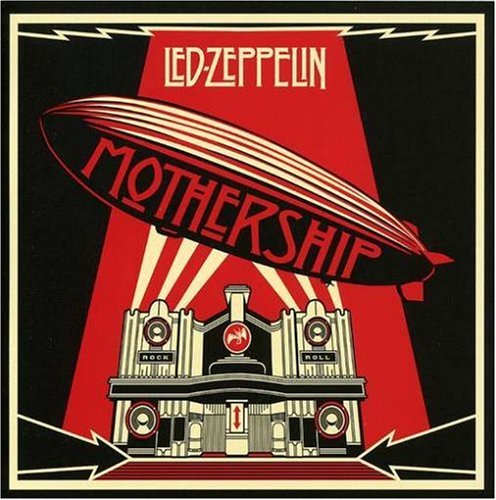Led Zeppelin were an English rock band, active in the late 1960s and throughout the 1970s. Formed as the New Yardbirds in 1968, the band consisted of guitarist Jimmy Page, singer Robert Plant, bassist/keyboardist John Paul Jones, and drummer John Bonham. They are widely considered to be one of the most successful, innovative and influential rock groups in history.
Led Zeppelin are one of the best-selling music artists in the history of audio recording—various sources estimate the group's sales at more than 200 or even 300 million albums worldwide. Their 111.5 million certified units in the United States rank them as the second-best-selling band in the US. Each of their nine studio albums reached the top 10 of the Billboard album chart in the US, with six reaching the number-one spot.[3] Rolling Stone magazine described them as "the heaviest band of all time",[4] "the biggest band of the '70s"[5] and "unquestionably one of the most enduring bands in rock history".[6] Similarly, the Rock and Roll Hall of Fame stated that the band were "as influential in that decade [the 1970s] as The Beatles were in the prior one
In 1966, Jimmy Page joined the blues-influenced rock band, The Yardbirds, to replace bassist Paul Samwell-Smith. Page soon switched from bass to lead guitar, creating a dual lead-guitar line-up with Jeff Beck. Following Beck's departure in October 1966, The Yardbirds—tired from constant touring and recording—began to wind down.[8] Page wanted to form a supergroup with himself and Beck on guitars, and The Who's Keith Moon and John Entwistle on drums and bass. Vocalists Steve Winwood and Steve Marriott were also considered for the project. The group never formed, although Page, Beck and Moon did record a song together in 1966, "Beck's Bolero", in a session that also included bassist-keyboardist John Paul Jones.
On 14 October 1968, the band announced the new name and played their first show at the University of Surrey in Guildford on 25 October; this was followed by a short British tour.[28] Richard Cole organised their first North American tour at the end of the year, and would become a major figure in the touring life of the group.[29] The first show was in Denver on 26 December 1968, followed by other East Coast dates before they moved to California to play Los Angeles and San Francisco.[30] The eponymous debut, Led Zeppelin, was released in the US during the tour on 12 January 1969. The UK release date was 31 March 1969. The album eventually peaked at number 10 on the Billboard chart and number 6 in the UK.
In the 1970s Led Zeppelin reached new heights of commercial and critical success that made them one of the most influential groups of the era, dwarfing their earlier achievements.[48][42] The band's image also changed as members began to wear elaborate, flamboyant clothing.[49] Led Zeppelin began travelling in a private jet airliner (nicknamed The Starship), rented out entire sections of hotels (including the Continental Hyatt House in Los Angeles, known colloquially as the "Riot House"), and became the subject of frequently repeated stories of debauchery.
Hiatus from touring and return (1975–77)
Plant and Page perform in Chicago in April 1977, during Led Zeppelin's last North American tour
Following their triumphant Earls Court appearances, Led Zeppelin took a holiday and planned an autumn tour in America, scheduled to open with two outdoor dates in San Francisco. In August 1975, however, Plant and his wife Maureen were involved in a serious car crash while on holiday in Rhodes, Greece. Plant suffered a broken ankle and Maureen was badly injured; a blood transfusion saved her life.[71] Unable to tour, he headed to the Channel Island of Jersey to spend August and September recuperating, with Bonham and Page in tow.
Bonham's death and break-up (1978–80)
After the death of Bonham (pictured in 1975) on 25 September 1980, the remaining members of Led Zeppelin decided to disband the group
In November 1978 the group recorded at Polar Studios in Stockholm, Sweden. The resulting album, In Through the Out Door, exhibited sonic experimentation that again drew mixed reactions from critics. Nevertheless, the album reached number one in the UK and the US in just its second week on the Billboard album chart. With this album's release, Led Zeppelin's entire catalogue returned to the Billboard Top 200 in the weeks of 27 October and 3 November 1979.
Musical style
John Bonham, on stage in the US around 1975, whose aggressive drumming style was critical to the hard rock sound associated with the band
Led Zeppelin's music was rooted in the blues.[14] The influence of abrupt, non-fluid American blues of Howlin' Wolf, Muddy Waters and Skip James was particularly apparent, especially on Led Zeppelin I and II.[124] Tracks were structured around the twelve-bar blues on every studio album except one, and the blues directly and indirectly influenced other songs both musically and lyrically.
Legacy
Plant, on stage in New York in 1973, whose vocal style has been highly influential in rock music
Led Zeppelin are widely considered to be one of the most successful, innovative and influential rock bands in the history of music.[152] Rock critic Mikal Gilmore said, "Led Zeppelin—talented, complex, grasping, beautiful and dangerous—made one of the most enduring bodies of composition and performance in twentieth-century music, despite everything they had to overpower, including themselves"
Discography
Main article: Led Zeppelin discography
Studio albums
Led Zeppelin (1969)
Led Zeppelin II (1969)
Led Zeppelin III (1970)
Led Zeppelin IV (1971)
Houses of the Holy (1973)
Physical Graffiti (1975)
Presence (1976)
In Through the Out Door (1979)
Coda (1982)





No hay comentarios:
Publicar un comentario